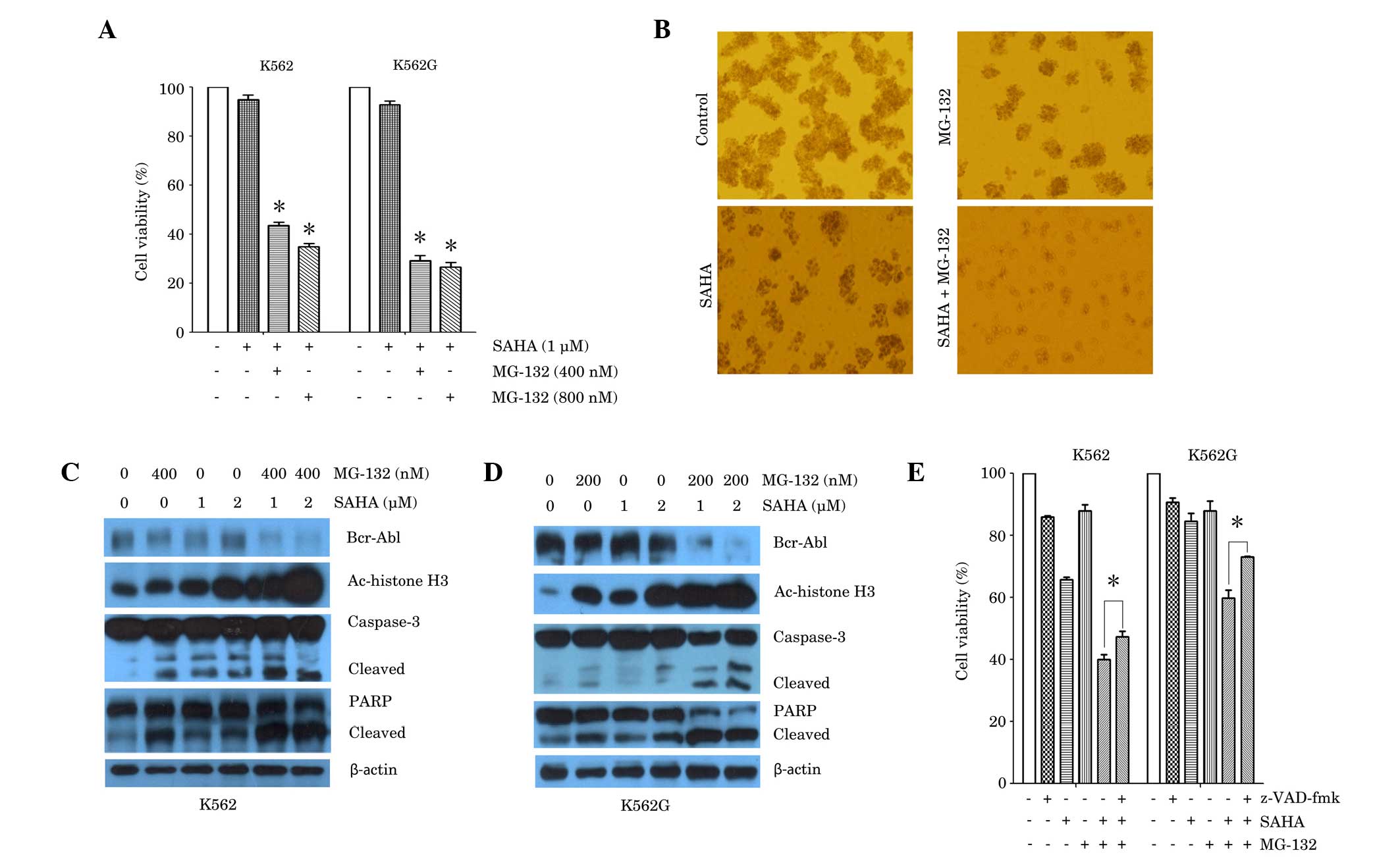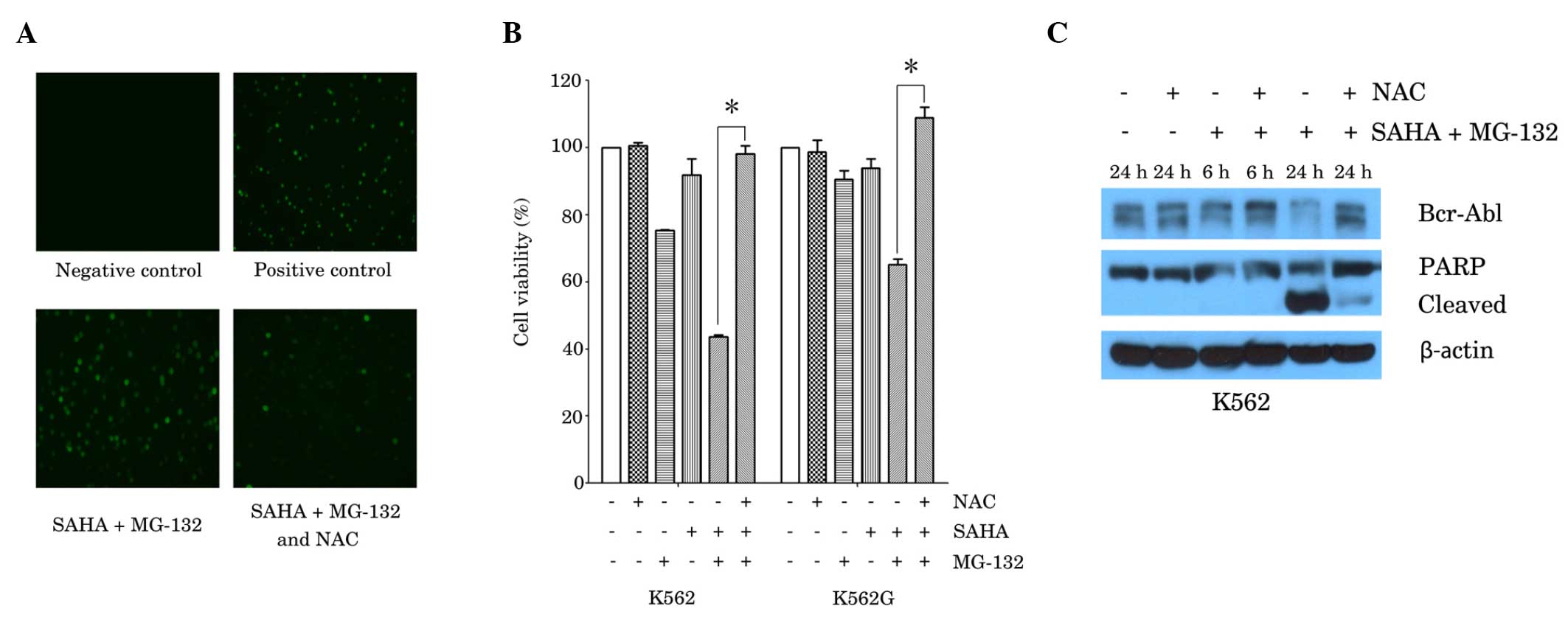|
1
|
Yang C, Yang J, Sun M, Yan J, Meng X and
Ma T: Alantolactone inhibits growth of K562/adriamycin cells by
downregulating Bcr/Abl and P-glycoprotein expression. IUBMB Life.
65:435–444. 2013. View
Article : Google Scholar : PubMed/NCBI
|
|
2
|
Melo JV and Chuah C: Novel agents in CML
therapy: Tyrosine kinase inhibitors and beyond. Hematology Am Soc
Hematol Educ Program. 427–435. 2008. View Article : Google Scholar : PubMed/NCBI
|
|
3
|
Carafa V, Nebbioso A and Altucci L:
Histone deacetylase inhibitors: Recent insights from basic to
clinical knowledge & patenting of anti-cancer actions. Recent
Pat Anticancer Drug Discov. 6:131–145. 2011. View Article : Google Scholar : PubMed/NCBI
|
|
4
|
Lemal R, Ravinet A, Moluçon-Chabrot C, Bay
JO and Guièze R: Histone deacetylase inhibitors in the treatment of
hematological malignancies. Bull Cancer. 98:867–878. 2011.(In
French). PubMed/NCBI
|
|
5
|
O'Connor OA, Heaney ML, Schwartz L,
Richardson S, Willim R, MacGregor-Cortelli B, Curly T, Moskowitz C,
Portlock C, Horwitz S, et al: Clinical experience with intravenous
and oral formulations of the novel histone deacetylase inhibitor
suberoylanilide hydroxamic acid in patients with advanced
hematologic malignancies. J Clin Oncol. 24:166–173. 2006.
View Article : Google Scholar : PubMed/NCBI
|
|
6
|
Kelly WK and Marks PA: Drug insight:
Histone deacetylase inhibitors-development of the new targeted
anticancer agent suberoylanilide hydroxamic acid. Nat Clin Pract
Oncol. 2:150–157. 2005. View Article : Google Scholar : PubMed/NCBI
|
|
7
|
Yamamoto S, Tanaka K, Sakimura R, Okada T,
Nakamura T, Li Y, Takasaki M, Nakabeppu Y and Iwamoto Y:
Suberoylanilide hydroxamic acid (SAHA) induces apoptosis or
autophagy-associated cell death in chondrosarcoma cell lines.
Anticancer Res. 28:1585–1591. 2008.PubMed/NCBI
|
|
8
|
Nimmanapalli R, Fuino L, Stobaugh C,
Richon V and Bhalla K: Cotreatment with the histone deacetylase
inhibitor suberoylanilide hydroxamic acid (SAHA) enhances
imatinib-induced apoptosis of Bcr-Abl-positive human acute leukemia
cells. Blood. 101:3236–3239. 2003. View Article : Google Scholar : PubMed/NCBI
|
|
9
|
Carew JS, Nawrocki ST, Kahue CN, Zhang H,
Yang C, Chung L, Houghton JA, Huang P, Giles FJ and Cleveland JL:
Targeting autophagy augments the anticancer activity of the histone
deacetylase inhibitor SAHA to overcome Bcr-Abl-mediated drug
resistance. Blood. 110:313–322. 2007. View Article : Google Scholar : PubMed/NCBI
|
|
10
|
Fiskus W, Wang Y, Joshi R, Rao R, Yang Y,
Chen J, Kolhe R, Balusu R, Eaton K, Lee P, et al: Cotreatment with
vorinostat enhances activity of MK-0457 (VX-680) against acute and
chronic myelogenous leukemia cells. Clin Cancer Res. 14:6106–6115.
2008. View Article : Google Scholar : PubMed/NCBI
|
|
11
|
Yu C, Rahmani M, Conrad D, Subler M, Dent
P and Grant S: The proteasome inhibitor bortezomib interacts
synergistically with histone deacetylase inhibitors to induce
apoptosis in Bcr/Abl+ cells sensitive and resistant to STI571.
Blood. 102:3765–3774. 2003. View Article : Google Scholar : PubMed/NCBI
|
|
12
|
Guo N and Peng Z: MG132, A proteasome
inhibitor, Induces apoptosis in tumor cells. Asia Pac J Clin Oncol.
9:6–11. 2013. View Article : Google Scholar : PubMed/NCBI
|
|
13
|
Jagani Z, Song K, Kutok JL, Dewar MR,
Melet A, Santos T, Grassian A, Ghaffari S, Wu C, Yeckes-Rodin H, et
al: Proteasome inhibition causes regression of leukemia and
abrogates BCR-ABL-induced evasion of apoptosis in part through
regulation of forkhead tumor suppressors. Cancer Res. 69:6546–6555.
2009. View Article : Google Scholar : PubMed/NCBI
|
|
14
|
Miller CP, Ban K, Dujka ME, McConkey DJ,
Munsell M, Palladino M and Chandra J: NPI-0052, a novel proteasome
inhibitor, induces caspase-8 and ROS-dependent apoptosis alone and
in combination with HDAC inhibitors in leukemia cells. Blood.
110:267–277. 2007. View Article : Google Scholar : PubMed/NCBI
|
|
15
|
Tong Y, Liu YY, You LS and Qian WB:
Perifosine induces protective autophagy and upregulation of ATG5 in
human chronic myelogenous leukemia cells in vitro. Acta
Pharmacol Sin. 33:542–550. 2012. View Article : Google Scholar : PubMed/NCBI
|
|
16
|
Park WH and Kim SH: MG132, a proteasome
inhibitor, induces human pulmonary fibroblast cell death via
increasing ROS levels and GSH depletion. Oncol Rep. 27:1284–1291.
2012.PubMed/NCBI
|
|
17
|
Heaney NB and Holyoake TL: Therapeutic
targets in chronic myeloid leukaemia. Hematol Oncol. 25:66–75.
2007. View
Article : Google Scholar : PubMed/NCBI
|
|
18
|
Marks PA, Richon VM and Rifkind RA:
Histone deacetylase inhibitors: Inducers of differentiation or
apoptosis of transformed cells. J Natl Cancer Inst. 92:1210–1216.
2000. View Article : Google Scholar : PubMed/NCBI
|
|
19
|
Gorre ME and Sawyers CL: Molecular
mechanisms of resistance to STI571 in chronic myeloid leukemia.
Curr Opin Hematol. 9:303–307. 2002. View Article : Google Scholar : PubMed/NCBI
|
|
20
|
Shah NP, Nicoll JM, Nagar B, Gorre ME,
Paquette RL, Kuriyan J and Sawyers CL: Multiple BCR-ABL kinase
domain mutations confer polyclonal resistance to the tyrosine
kinase inhibitor imatinib (STI571) in chronic phase and blast
crisis chronic myeloid leukemia. Cancer Cell. 2:117–125. 2002.
View Article : Google Scholar : PubMed/NCBI
|
|
21
|
Sankari SL, Masthan KM, Babu NA,
Bhattacharjee T and Elumalai M: Apoptosis in cancer-an update.
Asian Pac J Cancer Prev. 13:4873–4878. 2012. View Article : Google Scholar : PubMed/NCBI
|
|
22
|
Azad MB, Chen Y and Gibson SB: Regulation
of autophagy by reactive oxygen species (ROS): Implications for
cancer progression and treatment. Antioxid Redox Signal.
11:777–790. 2009. View Article : Google Scholar : PubMed/NCBI
|
|
23
|
Ling LU, Tan KB, Lin H and Chiu GN: The
role of reactive oxygen species and autophagy in safingol-induced
cell death. Cell Death Dis. 2:e1292011. View Article : Google Scholar : PubMed/NCBI
|
|
24
|
Stein SJ and Baldwin AS: NF-κB suppresses
ROS levels in BCR-ABL(+) cells to prevent activation of JNK and
cell death. Oncogene. 30:4557–4566. 2011. View Article : Google Scholar : PubMed/NCBI
|
|
25
|
Nguyen T, Dai Y, Attkisson E, Kramer L,
Jordan N, Nguyen N, Kolluri N, Muschen M and Grant S: HDAC
inhibitors potentiate the activity of the BCR/ABL kinase inhibitor
KW.2449 in imatinib. sensitive or. resistant BCR/ABL+leukemia cells
in vitro and in vivo. Clin Cancer Res. 17:3219–3232. 2011.
View Article : Google Scholar : PubMed/NCBI
|

















